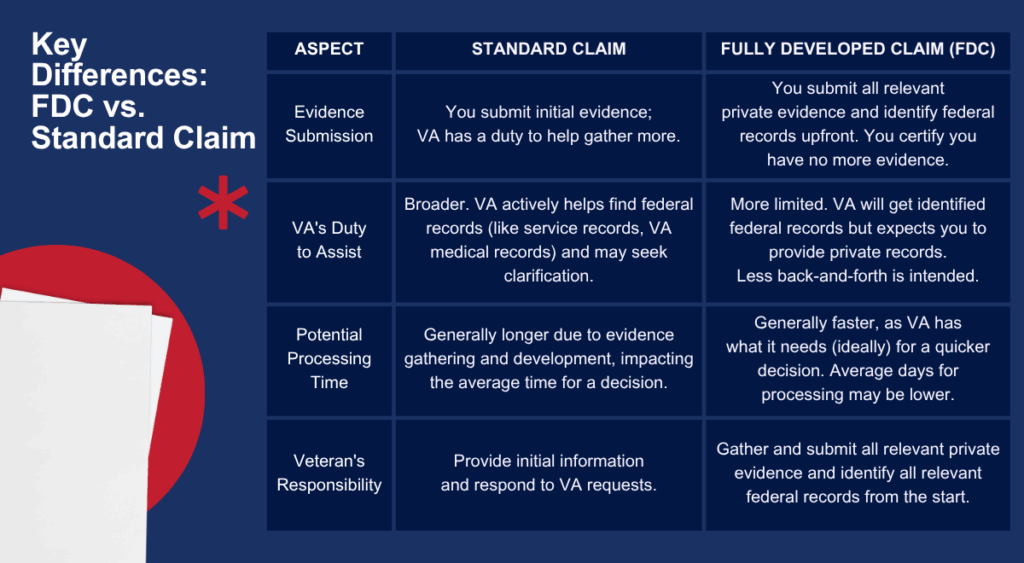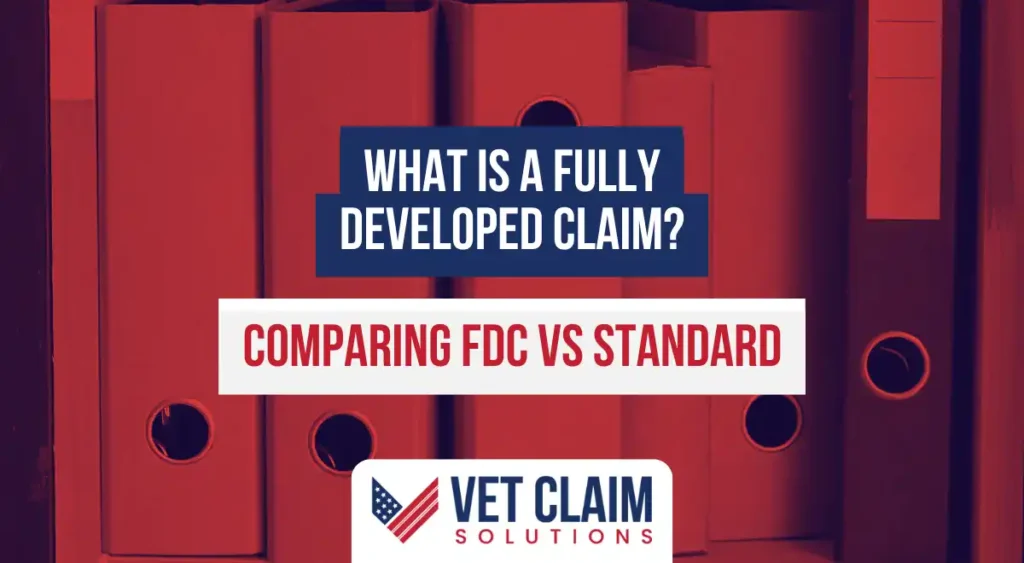Figuring out VA claims can feel like a tough puzzle. You served your country, and now you need support for your service-connected conditions. You’ve heard terms like “Standard Claim” and “Fully Developed Claim,” but what do they really mean for you?
You’re likely wondering, “What Is a Fully Developed Claim (FDC)? Compares standard vs. FDC claims and when to use each.” Understanding this difference is very important because it can affect how quickly you might get a decision on your disability benefits. Knowing about “What Is a Fully Developed Claim (FDC)? Compares standard vs. FDC claims and when to use each.” can put you in a better position to handle your VA claim effectively.
You want your claim processed correctly and as fast as possible, which is completely understandable. We’re here to walk through these claim types together, so you feel more confident about the path ahead in your claims process.

Understanding VA Disability Claims: The Basics
A VA disability claim is your formal request to the Department of Veterans Affairs for benefits. These benefits are for health conditions, injuries, or illnesses that started or worsened due to your active military service. Establishing a clear service connection is a fundamental part of a successful disability claim.
This process is a way for veterans to receive disability compensation and access necessary medical care for these service-connected issues. Submitting an accurate and complete claim from the outset can significantly impact the smoothness and speed of receiving your VA benefits. While this article focuses on disability claims for veterans, it’s worth noting that other claim types, like Dependency and Indemnity Compensation (DIC) claims for eligible surviving family members, also have specific processes and requirements.
You can file your VA claim in several ways. Many veterans find it convenient to use the VA.gov website for online submission.
The overall aim is to help you access the veterans benefits you have rightfully earned. Therefore, a good understanding of the claims program helps you take an active and informed role in your own case.
What is a Standard VA Claim?
A Standard VA Claim, sometimes referred to as a non-fully developed claim, is one pathway to apply for disability benefits. When you file a standard claim, you inform the VA about your condition and provide initial information. A key feature of standard claims is the VA’s “duty to assist.”
This duty means the VA is obligated to help you obtain certain evidence. For instance, they will attempt to gather your service treatment records and any VA medical records if you were treated at a VA medical center or federal facility. The VA will also try to get other federal records, like Social Security disability records, provided you identify them sufficiently.
However, under this process, the VA might need to ask you for more information or clarification multiple times. This back-and-forth communication can extend the processing time for standard claims. So, while the VA’s assistance is valuable, it can also contribute to a longer wait for a decision on your va disability claim.
Timelines for standard claims can vary widely; some veterans may wait many months, or even longer. This waiting period can be quite frustrating, particularly when you are managing health issues and need support. Common challenges include delays because the VA is awaiting records or requires further details from you, highlighting why knowing your options, including the Fully Developed Claims program, is so important.
What Is a Fully Developed Claim (FDC)? Compares standard vs. FDC claims and when to use each.
You’re looking for information on Fully Developed Claims, or FDCs. The FDC program is an initiative by the VA intended to expedite the claims process. While faster processing sounds appealing, it requires more preparatory work from you, the veteran.

Defining a Fully Developed Claim (FDC)
A Fully Developed Claim (FDC) is a type of disability claim where you, the veteran, submit all relevant private evidence in your possession and identify all relevant federal records at the same time you file your VA claim. This is the core principle of a developed claim. You are essentially presenting your case with all supporting documentation upfront.
As part of this claims program, you must also certify that you have no more evidence to give the VA at that moment. “All relevant evidence” encompasses private medical records pertaining to your claimed condition, such as reports from your personal doctors or specialists. It also means clearly identifying any federal records, like those from a VA medical center or Social Security Administration, so the VA can attempt to obtain them for your disability claims.
By providing all known, relevant information and records from the start, the goal is for the VA to review your file and reach a decision more quickly. This approach places significant responsibility on you to gather and organize your documentation for the fdc program. The VA offers detailed guidance on what constitutes a complete FDC submission on its website.
Key Differences: FDC vs. Standard Claim
Understanding the primary distinctions between these two types of claims can help you decide which path is most suitable for your circumstances. It involves considering not just the potential speed of processing but also the level of effort required from you versus the VA. Here’s a comparison to clarify how they differ.
The fully developed claims program has distinct requirements compared to the standard claims process. A proactive approach is necessary for an FDC, which can be a notable shift from how non-fully developed claims have traditionally been handled.

With an FDC, you take the lead in collecting most of your evidence. For a standard claim, the VA assumes more of the responsibility for searching for records, but this also typically adds to the processing time. Consider how much evidence you already possess or can readily access when deciding on your approach to a VA disability claim.
It’s important to note that the VA will still schedule a Compensation and Pension (C&P) medical exam if they determine it’s necessary for either type of claim. Therefore, filing an FDC does not guarantee you will bypass this step if the VA decides an exam is needed to evaluate your claimed condition. This medical exam is often a critical piece of evidence for many disability compensation claims.
Benefits of Filing an FDC
The most significant advantage of filing an FDC is the potential for a quicker decision on your disability benefits. Because you provide the VA with a comprehensive package of evidence at the outset, they may not need to spend as much time requesting documents or information. This can considerably reduce the wait time, and VA claims data often shows FDCs are completed faster.
Additionally, you have more direct control over the evidence the VA reviews from the very beginning of your developed claim. You select the documents you believe best support your case, allowing you to present your strongest arguments upfront. The reduction in back-and-forth communication with the VA can also lessen stress, as you are less likely to be waiting for frequent letters requesting more information.
A faster decision through the fdc program can lead to quicker access to disability compensation and essential healthcare services. This is especially vital when you are managing service-connected health issues. The VA promotes the Fully Developed Claims program as a key initiative to improve claims processing efficiency and reduce the backlog of pending claims.
When Might an FDC Not Be the Best Choice?
While an FDC sounds advantageous, it isn’t always the ideal option for every veteran or every situation. If gathering all your necessary evidence will take an exceptionally long time, filing an FDC might inadvertently delay your potential effective date. Your effective date, which determines when your veterans benefits begin, is often the date the VA receives your claim or your Intent to File form.
In some cases, it might be more beneficial to submit a standard claim to establish that earlier date, even if the claim itself takes longer to process. If you genuinely need the VA’s assistance to locate certain federal records and are unsure where they are, a standard claim could be more appropriate due to the VA’s broader duty to assist. While you must identify federal records for an FDC, if you’re truly struggling to locate them, the standard path offers more VA involvement in the search.
Furthermore, if you are uncertain about what specific evidence is needed for your particular condition, attempting to make an FDC “fully developed” might feel overwhelming, and you risk omitting crucial information. It’s about balancing potential speed against thoroughness and your capacity to gather all required documents. Choosing the standard claim path is a perfectly valid decision if it better suits your needs and circumstances.

How to File a Fully Developed Claim
If you have determined that a Fully Developed Claim is the right approach for you, understanding the steps involved is crucial. Organization and preparation are vital to successfully submitting an FDC. It’s about ensuring all your documentation is in order before you formally submit your claim.
Gathering Your Evidence: The Crucial First Step
This phase involves the most significant upfront work for your FDC. You need to collect all documentation related to the conditions you are claiming. This includes your Service Treatment Records (STRs) if the VA does not already possess them or if you have personal copies. Also, gather any VA medical records if you have received treatment at VA facilities, and all private medical records from civilian doctors, hospitals, or clinics concerning your claimed condition.
Lay statements, often called “buddy letters”, can also be very persuasive pieces of evidence. These are written statements from you, your spouse, other family members, friends, or fellow service members who have firsthand knowledge of your condition and how it connects to your military service or how your personnel records relate to your current disabilities. Testimony from law enforcement personnel or clergy members who know you well can also be valuable if they can speak to your condition’s impact or onset.
Consider the full spectrum of evidence that could support your claim for service connection. For certain conditions, obtaining a “nexus letter” from a medical professional, which explicitly links your condition to your service, can be very beneficial, though not always a strict requirement. Your military personnel records, including your DD214, are fundamental, but also look for any military personnel records relate to specific incidents or exposures.
If you are claiming conditions related to specific circumstances like Gulf War service, gather evidence of your deployment and any symptoms that align with common Gulf War illnesses. For Agent Orange exposure, records of service in qualifying locations and medical evidence of presumptive conditions are important. If your claim involves a traumatic brain injury, compile incident reports, initial medical evaluations, and records of ongoing treatment. For conditions like sleep apnea, include sleep study results, documentation of CPAP use, and evidence linking it to your service.
Sometimes, service records don’t include every detail, or records don’t include the specific incident you recall. If records are missing, perhaps due to events like the 1973 fire at the National Personnel Records Center in St. Louis that destroyed records, you may need to reconstruct your file using alternative sources. The VA is aware that St. Louis destroyed records held there, and they have procedures to help veterans in such situations. Information about records held at any national personnel records center or other records center might be needed. The more complete and well-organized your health records and other evidence, the stronger your FDC will be.
Completing the Right Forms
The primary form for disability compensation is VA Form 21-526EZ, “Application for Disability Compensation and Related Compensation Benefits.” When completing this application, you must clearly indicate that you are filing a Fully Developed Claim. There is typically a specific section or checkbox for this designation.
It is vital to fill out the form entirely and accurately. Any missing information or errors can lead to delays in your claims processing, even with an FDC. Double-check all personal details, service information, and the specific conditions you are claiming for your VA disability.
The VA website, VA.gov, is the best source for the most current versions of these forms. It is a good practice to download them directly from the official site before you begin.
Submitting Your FDC
Once your VA Form 21-526EZ is complete and you have gathered all your supporting evidence, it is time to submit your FDC. The most common and often most efficient method is online submission through the VA.gov portal. The online system will guide you through the process of uploading your documents and your signed application.
Alternatively, you can mail your completed application and all accompanying evidence to the VA claims intake center. The correct mailing address is usually provided on the VA form itself or can be found on the VA website. Be sure to send it via a method that provides tracking.

Common Pitfalls to Avoid with FDCs
Filing an FDC can be an effective strategy, but there are common mistakes veterans sometimes make. Being aware of these potential pitfalls can help you avoid them. The most significant issue is submitting a developed claim that is not actually “fully developed” in the VA’s view.
If the VA determines that your submission is missing key private evidence that you should have provided, or if you failed to identify crucial federal records, they may reclassify your FDC as a standard claim. This reclassification means it will likely take longer to process, moving it out of the faster FDC queue. This undermines the primary benefit of the fully developed claims program.
Forgetting to sign and date the certification stating that you have no more evidence to submit is another critical error. This certification is a mandatory part of the FDC program. Also, be certain that you have included all relevant private medical records. Sometimes veterans overlook records from a specialist, a brief hospital stay, or outpatient therapy, but these health records could be important for establishing service connection or the severity of your claimed condition.
A misunderstanding of what “all relevant evidence” entails can also lead to an incomplete FDC submission. Lastly, avoid significantly delaying the submission of your claim just because you are trying to make it an FDC if that delay means you might lose an earlier effective date for your veterans benefits. It’s a balance; if gathering one final piece of private evidence will take many months, consider if filing an Intent to File form followed by a standard claim might be a better strategy. The VA website explains the Intent to File process, which can help secure an earlier effective date while you gather your documents.
When Should You Choose an FDC over a Standard Claim?
So, when is a Fully Developed Claim definitely the route you should consider? An FDC is a good choice if you already have, or can quickly obtain, all your necessary medical records and service files. This includes private doctor records, hospital reports, your DD214, and any other relevant military personnel records.
If you are well-organized and have your paperwork readily available, the FDC path could be ideal for your VA claim. You should also feel reasonably confident about the strength of the evidence supporting your disability claim. If you believe your records clearly demonstrate the service connection for your condition and its current severity, an FDC allows you to present that compelling case directly and upfront.
And, of course, if your primary goal is to receive the fastest possible decision from the Department of Veterans Affairs, the FDC program is structured for that purpose. Remember, this path requires you to undertake more of the initial legwork in gathering evidence for your compensation claims. However, the potential reward can be a quicker resolution and earlier access to your earned disability benefits.
Ultimately, the choice between an FDC and a standard claim depends on your individual circumstances, your ability to gather comprehensive documentation, and the urgency of your need for benefits. If you’ve diligently prepared and assembled thorough evidence, an FDC can be a very effective way to pursue your VA disability benefits.
Standard Claims: When Are They More Appropriate?
While FDCs aim for quicker processing times, standard claims, or non-fully developed claims, still have an important role. A standard claim might be a more suitable option if you require significant assistance from the VA to obtain records. This is particularly true for older federal records that might be challenging for you to locate on your own from a records center or federal facility.
The VA’s “duty to assist” is more extensive with standard claims, meaning they will undertake more of the search for these official documents. This can be invaluable if, for example, your service records don’t include critical information or records don’t adequately detail an event or exposure. The VA will make reasonable efforts to obtain records held by governmental agencies for these pending claims.
If you are filing very close to your discharge date from military service, it’s sometimes best to get a claim submitted quickly to establish an early effective date. Trying to gather every single piece of evidence for an FDC could delay this initial filing. In such cases, filing a standard claim, or even just an Intent to File form, gets your foot in the door with Veterans Affairs, and you can then work with the VA to develop the claim.
Also, if collecting all the evidence needed for an FDC would cause an unacceptable delay, perhaps pushing your claim submission out by many months, a standard claim allows you to start the claims process sooner. The VA’s responsibility to help you, as detailed on their site regarding their claims program, is a key feature of the standard process for those who need it. It helps make sure veterans are not left entirely on their own to find every piece of government paperwork, especially if some records are difficult to access or if some military personnel records were part of the St. Louis destroyed records.
What if My FDC Gets Reclassified as a Standard Claim?
Sometimes, you might submit what you believe is a complete Fully Developed Claim, but the VA determines it does not meet all the FDC program requirements. If this occurs, your claim will usually be moved into the standard claim processing lane. This development is not a denial of your claim, so there’s no need for immediate alarm.
This reclassification means your VA disability claim will be handled like any other standard claim, which often entails a longer processing time than an FDC. This can happen if the VA identifies missing federal records that you did not identify or failed to mention, or if you submit additional evidence after you have already filed your FDC and certified that you had no more evidence to provide. It can also happen if the VA determines that the evidence submitted isn’t sufficient to make a decision without further development on their part.
While it can be disappointing if you were anticipating the faster FDC processing, your claim remains active and is still moving forward through the system. The main impact of reclassification is that the timeline for receiving a decision on your disability compensation will likely be extended. The VA will continue to work on your claim, and their duty to assist will apply as it does to all standard or non-fully developed claims. The VA will notify you if your claim has been reclassified, and you can always check the status of your claim online through your VA.gov account to monitor its progress.
Conclusion
You’ve gained a better understanding of the distinctions between different VA claim types. Knowing “What Is a Fully Developed Claim (FDC)? Compares standard vs. FDC claims and when to use each.” genuinely gives you more control over your journey to obtaining VA benefits. The Fully Developed Claims program offers a pathway to potentially faster decisions on your disability claim, but it places greater responsibility on you to gather and submit all your evidence upfront.
Standard claims involve more VA assistance in the evidence-gathering phase of the claims process but generally take longer to resolve. Making an informed choice based on your specific situation, your capacity to collect all necessary documents (including medical records and military personnel records), and how quickly you need assistance is paramount. Comprehending “What Is a Fully Developed Claim (FDC)? Compares standard vs. FDC claims and when to use each.” is a significant step towards a more manageable and successful VA claims experience, helping you access the disability compensation and other veterans benefits you have earned.


